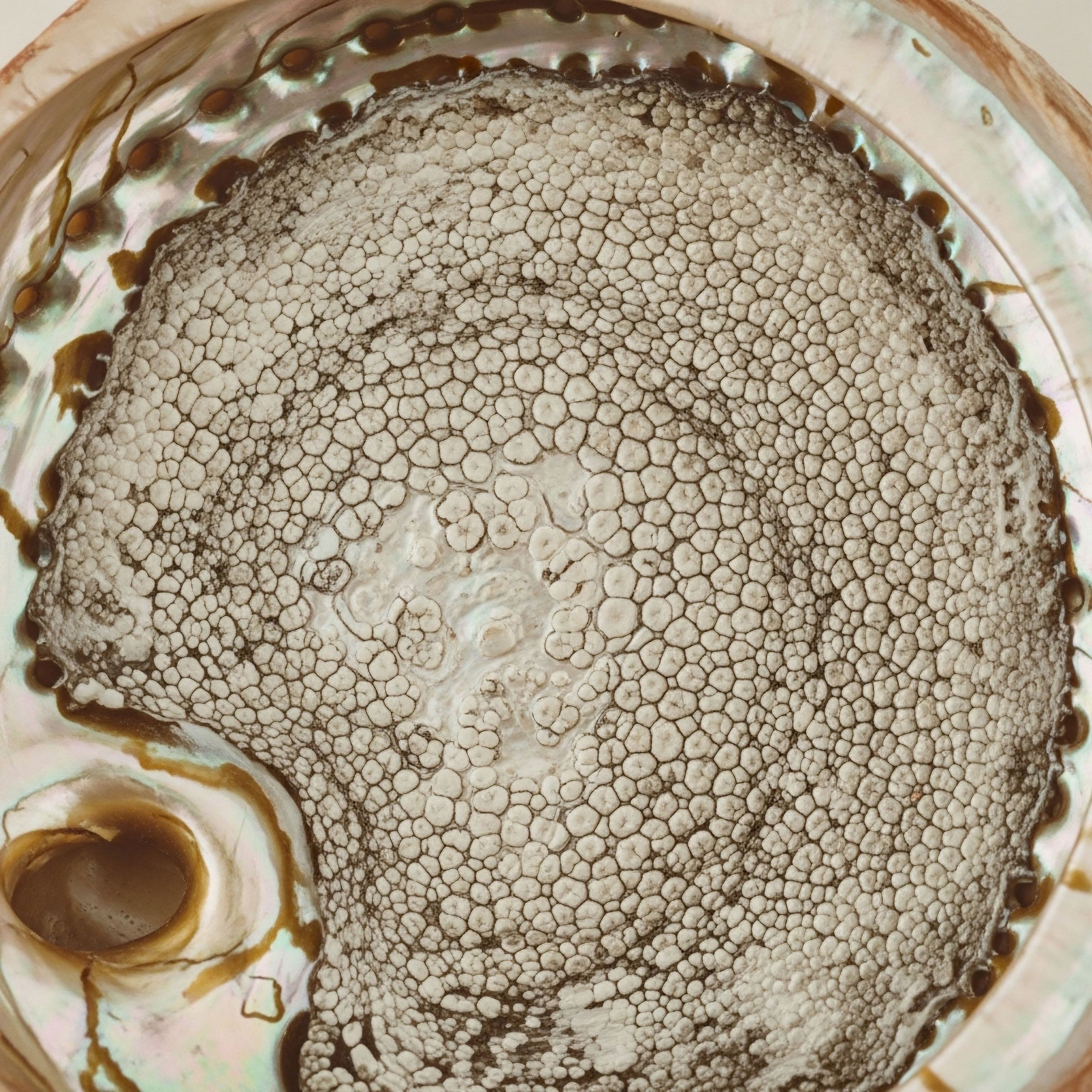

Fundamentals
Perhaps you have felt it ∞ a subtle shift in your daily rhythm, a persistent fatigue that sleep cannot resolve, or a creeping weight gain despite your best efforts. You might experience a mental fogginess, a diminished drive, or changes in your body’s natural cycles.
These sensations are not merely signs of aging or stress; they often signal a deeper, systemic imbalance within your biological architecture. Your body communicates with you through these signals, indicating that its intricate internal messaging system, the endocrine network, might be struggling to maintain its delicate equilibrium.
At the heart of many such experiences lies a condition known as insulin resistance. This state represents a fundamental disruption in how your cells respond to insulin, a vital hormone produced by the pancreas. Insulin’s primary role involves ushering glucose, derived from the foods you consume, into your cells for energy.
When cells become resistant, they require more and more insulin to perform this basic function. The pancreas, in response, works harder, producing ever-increasing amounts of insulin to compensate. This persistent elevation of insulin, or hyperinsulinemia, creates a cascade of effects throughout your entire physiology, extending far beyond blood sugar regulation.
The endocrine system operates as a grand orchestra, where each hormone plays a specific instrument, yet all are interconnected and influence one another. Insulin, a conductor in this orchestra, holds sway over many other hormonal players. When insulin signaling falters, it can disrupt the harmony of this entire system. This disruption can affect your thyroid function, alter your adrenal gland’s stress response, and significantly impact your reproductive hormones, leading to symptoms that might seem unrelated at first glance.
Insulin resistance represents a core metabolic imbalance that can ripple through the entire endocrine system, affecting various hormonal pathways.
Many individuals initially turn to lifestyle adjustments ∞ dietary changes, increased physical activity, stress reduction techniques ∞ with the hope of restoring balance. These interventions are undeniably foundational. They represent the first, and often most powerful, steps toward recalibrating your body’s metabolic machinery.
A well-structured nutritional approach, prioritizing whole, unprocessed foods and managing carbohydrate intake, can significantly improve cellular insulin sensitivity. Regular physical activity, particularly resistance training, helps cells become more receptive to insulin’s signals. Adequate sleep and effective stress management techniques support overall hormonal health by regulating cortisol and other stress hormones.

Understanding Insulin’s Far-Reaching Influence
Insulin’s influence extends beyond glucose transport. It plays a role in fat storage, protein synthesis, and even gene expression. When cells resist insulin’s call, the body attempts to overcome this resistance by producing more insulin. This sustained high insulin level can paradoxically contribute to weight gain, particularly around the abdomen, and can make weight loss efforts exceptionally challenging. The body becomes trapped in a cycle where excess insulin promotes fat storage, which in turn can worsen insulin resistance.
The impact of this metabolic state on other endocrine glands is profound. For instance, high insulin levels can directly stimulate the ovaries to produce more androgens, leading to conditions like Polycystic Ovary Syndrome (PCOS) in women. In men, insulin resistance can contribute to lower testosterone levels by affecting testicular function and increasing the conversion of testosterone to estrogen.
The thyroid gland, responsible for regulating metabolism, can also be affected, leading to sluggishness and other hypothyroid-like symptoms, even when standard thyroid tests appear within normal ranges.

The Interconnectedness of Hormonal Systems
Consider the intricate feedback loops that govern your hormonal health. The Hypothalamic-Pituitary-Adrenal (HPA) axis, which manages your stress response, is closely linked to insulin sensitivity. Chronic stress can elevate cortisol, which in turn can worsen insulin resistance. Similarly, the Hypothalamic-Pituitary-Gonadal (HPG) axis, which controls reproductive hormones, is highly sensitive to metabolic signals.
Disruptions in insulin signaling can directly impair the function of this axis, leading to irregular menstrual cycles, reduced fertility, and symptoms associated with hormonal decline in both men and women.
While lifestyle interventions form the bedrock of metabolic health, the question arises ∞ can they alone reverse advanced endocrine dysfunctions that have been silently progressing for years due to untreated insulin resistance? For early stages of metabolic imbalance, dedicated lifestyle changes often yield remarkable improvements.
However, when the system has been significantly challenged, and dysfunctions have become deeply entrenched, a more targeted, clinically guided approach may become necessary to restore optimal function and vitality. This is where a deeper understanding of personalized wellness protocols becomes essential.


Intermediate
When insulin resistance progresses, its effects on the endocrine system can become deeply embedded, moving beyond simple metabolic adjustments. The body’s internal communication pathways, once fluid and responsive, can become sluggish and unresponsive.
While dietary adjustments and regular physical activity remain fundamental, they may not always be sufficient to fully recalibrate a system that has been operating under significant stress for an extended period. This is where a clinically informed strategy, integrating targeted therapeutic protocols, becomes a powerful ally in restoring hormonal balance.
The persistent high insulin levels associated with insulin resistance can directly impact the production and regulation of various hormones. For instance, in men, chronic hyperinsulinemia can contribute to a decline in testosterone production by affecting the Leydig cells in the testes and altering the sensitivity of the pituitary gland to signals from the hypothalamus.
In women, this same mechanism can contribute to ovarian dysfunction, leading to conditions like PCOS, characterized by irregular periods, androgen excess, and often, difficulty with conception. The thyroid gland, the master regulator of metabolism, can also suffer, with insulin resistance potentially impairing the conversion of inactive thyroid hormone (T4) to its active form (T3), leading to symptoms of low thyroid function despite normal TSH levels.

Targeted Hormonal Optimization Protocols
For individuals experiencing advanced endocrine dysfunctions linked to insulin resistance, a personalized approach often involves specific hormonal optimization protocols. These are not merely about replacing what is missing; they are about restoring the body’s capacity for optimal function, often working synergistically with lifestyle changes.

Testosterone Replacement Therapy for Men
For men experiencing symptoms of low testosterone, such as reduced energy, diminished libido, mood changes, and muscle loss, often exacerbated by underlying insulin resistance, Testosterone Replacement Therapy (TRT) can be a transformative intervention. A common protocol involves weekly intramuscular injections of Testosterone Cypionate (typically 200mg/ml). This direct administration helps restore circulating testosterone levels to a healthy physiological range.
Targeted hormonal interventions can help restore endocrine balance when lifestyle changes alone are insufficient for advanced dysfunctions.
To maintain the body’s natural testosterone production and preserve fertility, TRT protocols frequently include additional medications. Gonadorelin, administered via subcutaneous injections twice weekly, stimulates the pituitary gland to release luteinizing hormone (LH) and follicle-stimulating hormone (FSH), which are crucial for testicular function.
To manage potential side effects such as the conversion of testosterone to estrogen, an oral tablet of Anastrozole is often prescribed twice weekly. This medication helps block the aromatase enzyme, reducing estrogen levels. In some cases, Enclomiphene may be incorporated to further support LH and FSH levels, particularly for men concerned with fertility preservation.

Testosterone Replacement Therapy for Women
Women, too, can experience the benefits of testosterone optimization, particularly those in pre-menopausal, peri-menopausal, or post-menopausal stages with symptoms like irregular cycles, mood fluctuations, hot flashes, and reduced libido. The protocols for women are carefully titrated to their unique physiology.
A typical approach involves weekly subcutaneous injections of Testosterone Cypionate, usually at a much lower dose, such as 10 ∞ 20 units (0.1 ∞ 0.2ml). This precise dosing helps achieve therapeutic levels without causing unwanted androgenic side effects. Progesterone is often prescribed, with its use tailored to the woman’s menopausal status and individual needs, supporting menstrual regularity in pre-menopausal women and providing protective benefits in peri- and post-menopausal women.
For some, pellet therapy, which involves the subcutaneous insertion of long-acting testosterone pellets, offers a convenient alternative. Anastrozole may also be used in women when appropriate, to manage estrogen levels, particularly in cases where testosterone conversion is a concern.

Post-TRT or Fertility-Stimulating Protocol for Men
For men who have discontinued TRT or are actively trying to conceive, a specific protocol is implemented to stimulate the body’s natural hormone production. This protocol often includes Gonadorelin to restart pituitary signaling, alongside selective estrogen receptor modulators (SERMs) like Tamoxifen and Clomid. These SERMs work by blocking estrogen’s negative feedback on the pituitary, thereby increasing LH and FSH secretion and stimulating endogenous testosterone production. Anastrozole may be optionally included to manage estrogen levels during this phase.

Growth Hormone Peptide Therapy
Beyond direct hormone replacement, targeted peptide therapies offer another avenue for metabolic and endocrine support, particularly for active adults and athletes seeking improvements in body composition, recovery, and overall vitality. These peptides work by stimulating the body’s own production of growth hormone, rather than directly replacing it.
| Peptide | Primary Mechanism | Therapeutic Benefits |
|---|---|---|
| Sermorelin | Stimulates natural growth hormone release from the pituitary. | Improved sleep quality, body composition, recovery. |
| Ipamorelin / CJC-1295 | Synergistic stimulation of growth hormone release, often combined. | Enhanced muscle gain, fat loss, anti-aging effects, tissue repair. |
| Tesamorelin | Specifically reduces visceral adipose tissue (belly fat). | Targeted fat reduction, cardiovascular health support. |
| Hexarelin | Potent growth hormone secretagogue, also supports appetite. | Muscle growth, increased strength, potential appetite stimulation. |
| MK-677 | Oral growth hormone secretagogue, long-acting. | Improved sleep, skin quality, muscle mass, bone density. |
These peptides can play a role in mitigating some of the downstream effects of insulin resistance, such as impaired fat metabolism and reduced muscle protein synthesis. By optimizing growth hormone levels, they support metabolic flexibility and cellular repair, contributing to a more resilient endocrine system.

Other Targeted Peptides for Specific Needs
Beyond growth hormone secretagogues, other peptides address specific aspects of health that can be compromised by chronic metabolic stress.
- PT-141 ∞ This peptide is specifically designed to address sexual health concerns, acting on the central nervous system to improve libido and sexual function in both men and women. Sexual dysfunction can often be a symptom of broader hormonal and metabolic imbalances, including those driven by insulin resistance.
- Pentadeca Arginate (PDA) ∞ PDA is recognized for its roles in tissue repair, wound healing, and modulating inflammatory responses. Chronic inflammation is a hallmark of insulin resistance and metabolic dysfunction. By supporting cellular repair and calming inflammatory pathways, PDA can contribute to a healthier internal environment, aiding the body’s recovery from metabolic stress.
Integrating these clinical protocols with diligent lifestyle interventions creates a powerful, synergistic strategy. Lifestyle changes lay the groundwork by improving cellular sensitivity, while targeted therapies address specific hormonal deficiencies or imbalances that have become too significant for lifestyle alone to correct. This combined approach offers a more comprehensive path toward reclaiming vitality and optimal endocrine function.


Academic
The question of whether lifestyle interventions alone can reverse advanced endocrine dysfunctions stemming from untreated insulin resistance requires a deep examination of cellular and molecular physiology. While foundational, lifestyle modifications face inherent limitations when the body’s compensatory mechanisms have been exhausted, and pathological adaptations have taken root. Understanding the intricate biological pathways involved clarifies why a multi-pronged approach, often including targeted clinical protocols, becomes not just beneficial, but frequently essential.
Insulin resistance, at its core, represents a failure of target cells ∞ primarily muscle, liver, and adipose tissue ∞ to respond appropriately to insulin’s signaling. This cellular recalcitrance leads to compensatory hyperinsulinemia, a state where the pancreas continuously overproduces insulin.
This chronic elevation of insulin is not benign; it acts as a potent endocrine disruptor, influencing a multitude of hormonal axes beyond glucose homeostasis. The cellular mechanisms involve defects in insulin receptor signaling, post-receptor phosphorylation cascades (e.g. IRS-1/PI3K/Akt pathway), and glucose transporter (GLUT4) translocation. These molecular aberrations contribute to a systemic metabolic inflexibility.

The Hypothalamic-Pituitary-Gonadal Axis and Insulin Resistance
The interplay between insulin resistance and the Hypothalamic-Pituitary-Gonadal (HPG) axis is particularly well-documented. In women, hyperinsulinemia is a primary driver of Polycystic Ovary Syndrome (PCOS). Elevated insulin directly stimulates ovarian stromal and theca cells to produce excess androgens, such as testosterone and androstenedione.
This androgen excess contributes to anovulation, menstrual irregularities, and clinical signs like hirsutism and acne. Insulin also reduces hepatic synthesis of sex hormone-binding globulin (SHBG), further increasing the bioavailability of androgens. Lifestyle interventions, such as dietary carbohydrate restriction and weight loss, can improve insulin sensitivity and, consequently, reduce ovarian androgen production.
However, in many cases of established PCOS, particularly those with significant hyperandrogenism or anovulation, pharmacological interventions targeting insulin sensitivity (e.g. metformin) or androgen excess (e.g. oral contraceptives, anti-androgens) are often required to restore ovulatory function and alleviate symptoms.
In men, insulin resistance and hyperinsulinemia are strongly associated with hypogonadism, characterized by low testosterone levels. Chronic high insulin can impair Leydig cell function in the testes, reducing testosterone synthesis. It can also affect the pulsatile release of gonadotropin-releasing hormone (GnRH) from the hypothalamus and the subsequent secretion of LH and FSH from the pituitary, thereby disrupting the central regulation of testosterone production.
Furthermore, increased adiposity, often a consequence of insulin resistance, leads to elevated aromatase activity in adipose tissue, converting testosterone into estrogen, which further suppresses GnRH and LH release. While weight loss and exercise can improve testosterone levels in some men with metabolic syndrome, the degree of improvement may be insufficient to normalize levels in cases of advanced, long-standing hypogonadism.
Advanced endocrine dysfunctions often require a multi-modal strategy, combining lifestyle changes with targeted clinical interventions to restore physiological balance.

Thyroid Function and Metabolic Interconnections
The thyroid gland, central to metabolic rate regulation, also experiences the ripple effects of insulin resistance. While direct causation is complex, studies suggest a bidirectional relationship. Insulin resistance can impair the peripheral conversion of thyroxine (T4) to the more metabolically active triiodothyronine (T3), potentially leading to a state of tissue hypothyroidism despite normal circulating TSH and T4 levels.
This phenomenon, sometimes termed “euthyroid sick syndrome” or “low T3 syndrome,” can be exacerbated by chronic inflammation and oxidative stress, both hallmarks of insulin resistance. Conversely, overt or subclinical hypothyroidism can worsen insulin resistance. Lifestyle interventions can improve metabolic markers, but restoring optimal T3 conversion and cellular thyroid hormone action in advanced cases may necessitate specific nutritional cofactors or, in some instances, T3 supplementation under clinical guidance.

Can Lifestyle Interventions Alone Reverse Advanced Endocrine Dysfunctions?
The term “reverse” implies a complete return to a pre-pathological state without external aid. For early or mild insulin resistance and its associated endocrine imbalances, lifestyle interventions can indeed achieve significant reversal. However, for advanced endocrine dysfunctions, where compensatory mechanisms are overwhelmed and structural or functional changes have occurred (e.g. ovarian cysts in PCOS, significant Leydig cell dysfunction), lifestyle alone often falls short of complete reversal.
Consider the concept of allostatic load ∞ the cumulative wear and tear on the body’s systems due to chronic stress, including metabolic stress. When this load becomes excessive, the body’s capacity for self-correction diminishes. At this point, targeted clinical interventions act as a precise external force to help reset the system, allowing lifestyle changes to then maintain the newly established equilibrium.

The Role of Growth Hormone and Peptides in Metabolic Recalibration
Growth hormone (GH) plays a critical role in metabolic regulation, influencing lipolysis, protein synthesis, and glucose metabolism. Insulin resistance can be associated with a state of relative GH deficiency or impaired GH signaling. Growth hormone-releasing peptides (GHRPs) and growth hormone-releasing hormones (GHRHs), such as Sermorelin and Ipamorelin/CJC-1295, stimulate the pulsatile release of endogenous GH from the pituitary gland. This endogenous stimulation is considered more physiological than exogenous GH administration.
By optimizing GH levels, these peptides can improve body composition (reducing adiposity, increasing lean muscle mass), enhance metabolic flexibility, and support cellular repair processes that are often compromised in states of chronic insulin resistance. For example, improved lean mass can increase insulin sensitivity in muscle tissue, creating a positive feedback loop. Clinical studies have shown that GHRH analogs can reduce visceral fat and improve lipid profiles, which are direct benefits for individuals with metabolic dysfunction.
| Biomarker | Typical Change with Lifestyle Alone (Mild-Moderate IR) | Potential Change with Combined Intervention (Advanced IR) |
|---|---|---|
| Fasting Insulin | Significant reduction | Further reduction, often to optimal physiological range |
| HbA1c | Improvement | Normalization or significant improvement |
| Testosterone (Men) | Modest increase | Substantial increase to healthy range |
| SHBG (Women) | Modest increase | Significant increase, reducing free androgen index |
| LH/FSH (Men) | Variable, often unchanged | Improved pulsatility and levels with Gonadorelin/SERMs |
| Body Fat Percentage | Reduction | Greater reduction, particularly visceral fat with peptides |
| Inflammatory Markers (e.g. hs-CRP) | Reduction | Further reduction, supported by peptides like PDA |
The integration of lifestyle changes with targeted hormonal and peptide therapies offers a synergistic effect. Lifestyle modifications address the root metabolic dysfunction, while specific clinical protocols directly correct or support the endocrine imbalances that have become entrenched. This comprehensive strategy provides a more robust and often necessary path to truly restore physiological function and reclaim vitality in the face of advanced endocrine dysfunctions caused by untreated insulin resistance.

Considering the Individual Biological Blueprint
Each person’s response to insulin resistance and subsequent interventions is unique, influenced by genetic predispositions, epigenetic factors, and individual lifestyle adherence. What works for one person may require modification for another. This underscores the necessity of a personalized wellness protocol, guided by detailed laboratory assessments and clinical expertise. The goal is not merely to suppress symptoms, but to restore the underlying biological systems to their optimal operating state, allowing the body to function with greater resilience and efficiency.

References
- Azziz, Ricardo. “The polycystic ovary syndrome ∞ current concepts and implications for the adolescent.” Annals of the New York Academy of Sciences 1135.1 (2008) ∞ 206-215.
- Dunaif, Andrea, and David R. Legro. “Insulin resistance and polycystic ovary syndrome.” Endocrine Reviews 18.6 (1997) ∞ 774-793.
- Grossmann, Mathis, and Robert J. McLachlan. “Testosterone and insulin resistance in men ∞ a review.” Current Opinion in Endocrinology, Diabetes and Obesity 21.3 (2014) ∞ 219-225.
- Corona, Giovanni, et al. “Insulin resistance and hypogonadism in men.” International Journal of Endocrinology 2011 (2011).
- Biondi, Bernadette, and Leonardo Wartofsky. “Treatment with thyroid hormone.” Endocrine Reviews 33.2 (2012) ∞ 269-316.
- Veldhuis, Johannes D. et al. “Physiological regulation of the human growth hormone (GH)-insulin-like growth factor I (IGF-I) axis ∞ relationship to body composition, metabolic status, and aging.” Endocrine Reviews 20.2 (1999) ∞ 185-207.
- Kahn, C. Ronald, et al. “Mechanisms of insulin action and resistance.” Diabetes Care 28.5 (2005) ∞ 1009-1017.
- Saltiel, Alan R. and C. Ronald Kahn. “Insulin signalling and the molecular mechanisms of insulin resistance.” Nature 414.6865 (2001) ∞ 799-806.

Reflection
As you consider the intricate dance of hormones and metabolic pathways within your own body, reflect on the signals it has been sending you. The journey toward reclaiming vitality is deeply personal, a continuous process of listening, learning, and responding. Understanding the biological underpinnings of your symptoms is the initial step, providing a map for your path forward.
This knowledge is not merely academic; it is empowering. It transforms vague discomforts into actionable insights, allowing you to partner with clinical guidance to restore your unique biological systems. Your body possesses an inherent capacity for balance, and with precise, personalized support, you can guide it back to its optimal state of function.
Consider what it means to truly understand your own biological systems. This understanding moves beyond simply addressing symptoms; it allows for a deeper, more enduring restoration of health. The insights shared here serve as a foundation, inviting you to consider the next steps in your personal wellness journey, always with the aim of achieving uncompromised vitality.



